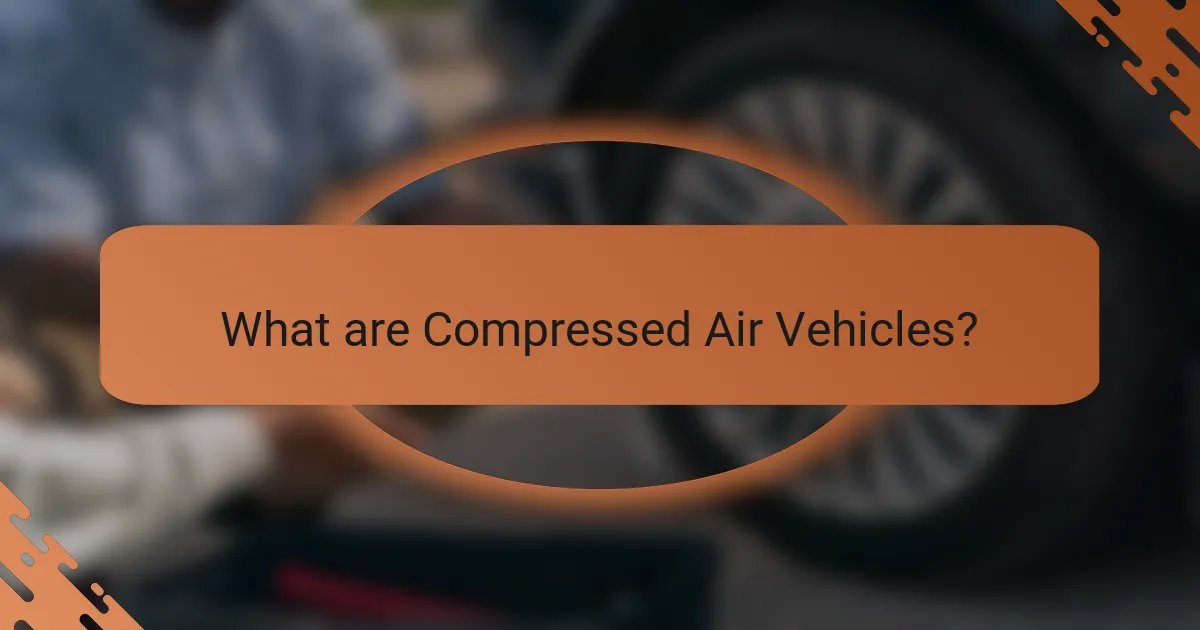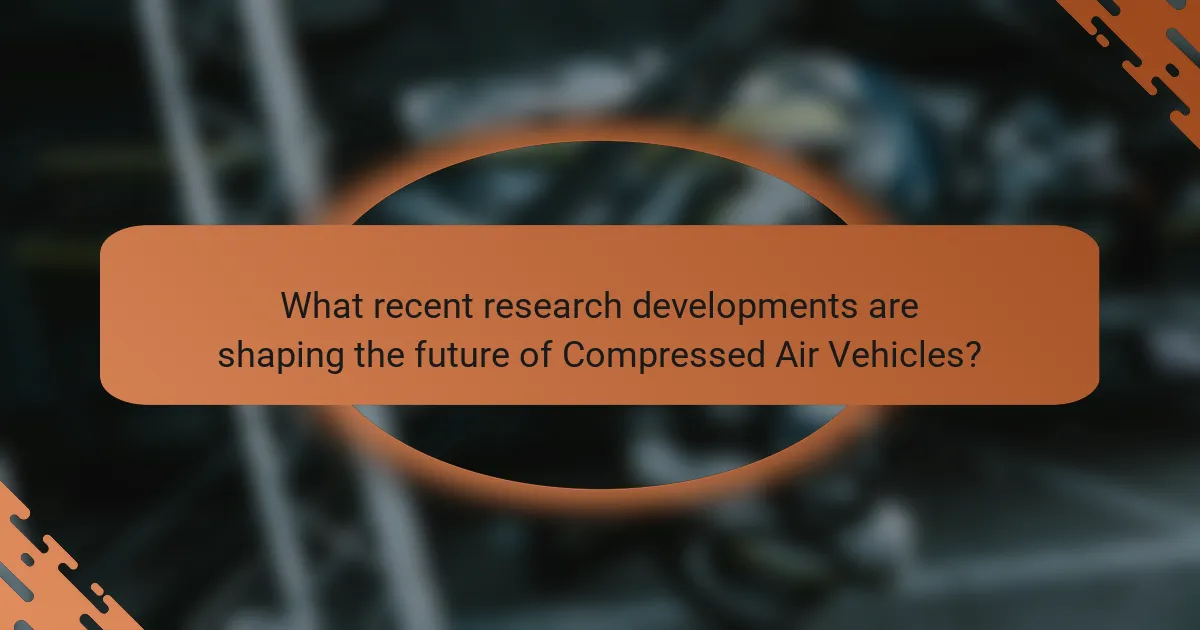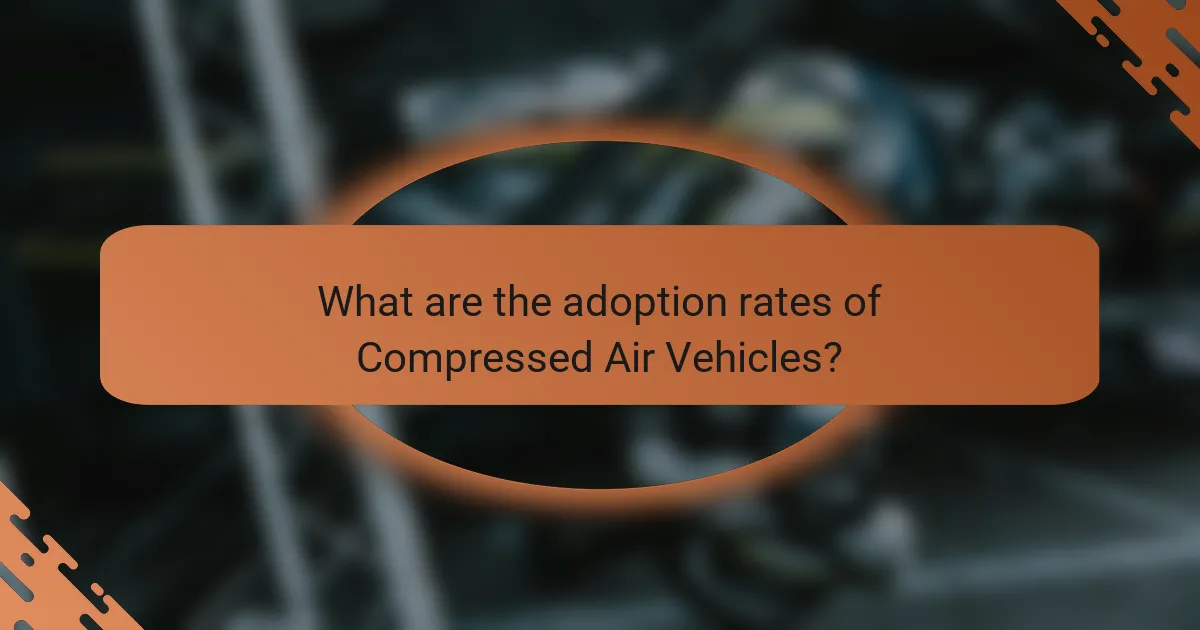Compressed air vehicles (CAVs) utilize compressed air as a power source for propulsion, converting stored energy into mechanical energy through the expansion of air. These vehicles present a clean alternative to traditional internal combustion engines, producing zero emissions and supporting environmental sustainability. The article examines current market trends indicating a rising interest in sustainable transportation solutions, alongside recent research developments aimed at enhancing energy efficiency and performance. Despite the potential of CAVs to reduce reliance on fossil fuels, adoption rates remain low due to limited commercial availability and infrastructure challenges. The discussion includes insights into key players, technological advancements, and future forecasts for the compressed air vehicle market.

What are Compressed Air Vehicles?
Compressed air vehicles are vehicles that use compressed air as a power source for propulsion. These vehicles operate by converting the energy stored in compressed air into mechanical energy. The technology is based on the principle of expanding compressed air to drive pistons or turbines. Compressed air vehicles can offer a clean and efficient alternative to traditional internal combustion engines. They produce zero emissions during operation, contributing to environmental sustainability. The concept has been explored in various prototypes and research projects. Companies like Motor Development International and Tata Motors have developed models showcasing this technology. Compressed air vehicles have the potential to reduce reliance on fossil fuels in the transportation sector.
How do Compressed Air Vehicles operate?
Compressed Air Vehicles operate by utilizing compressed air as a source of energy for propulsion. These vehicles store air in high-pressure tanks. When the vehicle is in motion, the stored air is released through a motor. This release of air creates thrust, propelling the vehicle forward. The process is efficient and produces zero emissions. Compressed air is often stored at pressures around 3000 psi. The technology is being researched for its potential to reduce reliance on fossil fuels. Prototypes have shown promising results in urban environments, indicating feasibility for future adoption.
What are the key components of Compressed Air Vehicles?
The key components of compressed air vehicles include the air storage tank, air compressor, propulsion system, and control system. The air storage tank holds compressed air at high pressure. The air compressor is responsible for compressing ambient air into the storage tank. The propulsion system converts the energy from compressed air into mechanical energy for movement. The control system manages the vehicle’s operations and performance. These components work together to enable the vehicle to operate efficiently using compressed air as a power source.
How does the air compression process work in these vehicles?
The air compression process in compressed air vehicles involves drawing in ambient air and compressing it to store energy. The vehicle’s compressor reduces the volume of air, increasing its pressure. This high-pressure air is then stored in tanks within the vehicle. When needed, the compressed air is released to drive pistons or turbines, converting stored energy into mechanical energy. This process allows the vehicle to move efficiently. Research shows that compressed air can achieve energy efficiencies comparable to traditional fuels, making it a viable alternative in the automotive market.
What advantages do Compressed Air Vehicles offer?
Compressed Air Vehicles (CAVs) offer several advantages. They produce zero emissions during operation. This characteristic significantly reduces air pollution. CAVs utilize compressed air as a clean energy source. This leads to lower operational costs compared to traditional fuel vehicles. CAVs have fewer moving parts, which reduces maintenance requirements. This simplicity in design enhances reliability and longevity. Additionally, they can be refueled quickly at dedicated stations. The potential for renewable energy integration further supports their sustainability.
How do Compressed Air Vehicles contribute to environmental sustainability?
Compressed Air Vehicles (CAVs) contribute to environmental sustainability by utilizing compressed air as a clean energy source. This method eliminates harmful emissions associated with traditional fossil fuel vehicles. CAVs operate without combustion, resulting in zero tailpipe emissions. According to research by the International Journal of Hydrogen Energy, CAVs can reduce greenhouse gas emissions significantly compared to gasoline-powered vehicles. Additionally, they promote energy efficiency by converting compressed air into mechanical energy with minimal energy loss. The use of renewable energy sources for air compression further enhances their sustainability. Overall, CAVs offer a viable alternative for reducing the environmental impact of transportation.
What are the cost benefits of using Compressed Air Vehicles?
Compressed Air Vehicles (CAVs) offer significant cost benefits. They typically have lower operational costs compared to traditional fuel vehicles. CAVs use compressed air as a power source, which is cheaper than gasoline or diesel. Maintenance costs are also reduced, as CAVs have fewer moving parts. This leads to lower wear and tear over time.
Additionally, CAVs can take advantage of lower energy prices for electricity used in air compression. Some studies indicate that CAVs can achieve fuel savings of up to 60% compared to conventional vehicles. The initial investment may be higher, but long-term savings on fuel and maintenance can offset this cost.
Overall, the cost benefits of using Compressed Air Vehicles make them an attractive option for eco-friendly transportation.

What are the current market trends for Compressed Air Vehicles?
Current market trends for compressed air vehicles indicate a growing interest in sustainable transportation solutions. The global push for reducing carbon emissions is driving research and development in this area. Companies are exploring compressed air technology as a viable alternative to traditional fuel sources. Key players are investing in innovative designs and prototypes. Recent studies show potential improvements in energy efficiency and reduced operational costs. Market forecasts suggest an increase in adoption rates over the next decade. Regulatory support is also enhancing market viability. Overall, compressed air vehicles are positioned as a promising option in the evolving automotive landscape.
How is the demand for Compressed Air Vehicles evolving?
The demand for Compressed Air Vehicles is increasing steadily. This growth is driven by rising environmental concerns. Consumers are seeking sustainable alternatives to traditional vehicles. Government regulations are also promoting cleaner technologies. Research shows a significant interest in non-fossil fuel options. Market reports indicate a projected increase in sales over the next decade. Innovations in compressed air technology are enhancing vehicle performance. These factors contribute to a positive outlook for Compressed Air Vehicles in the automotive market.
What factors are driving the growth of the Compressed Air Vehicle market?
The growth of the Compressed Air Vehicle market is driven by increasing demand for sustainable transportation solutions. Environmental concerns are prompting governments and consumers to seek alternatives to fossil fuels. Technological advancements in compressed air systems are improving vehicle efficiency and performance. Additionally, rising fuel prices are making compressed air vehicles more economically attractive. Investment in research and development is further enhancing the viability of this technology. Regulatory support for clean energy initiatives is also contributing to market expansion. These factors collectively position compressed air vehicles as a promising solution for future mobility challenges.
Which regions are leading in the adoption of Compressed Air Vehicles?
Europe and Asia are leading in the adoption of Compressed Air Vehicles. Countries like France and India are at the forefront. France has initiated several projects focused on compressed air technology for transportation. India is investing in research and development for sustainable vehicle solutions. Additionally, regions in Japan are also exploring this technology. The increasing demand for eco-friendly transportation drives this trend.
What challenges are faced in the Compressed Air Vehicle market?
The Compressed Air Vehicle market faces several challenges. Limited energy efficiency is a significant issue. Compressed air systems often have lower energy density compared to traditional fuels. This results in shorter driving ranges for vehicles. Infrastructure for refueling compressed air vehicles is also underdeveloped. There are few refueling stations available, making adoption difficult. Additionally, high manufacturing costs hinder market growth. Developing efficient and cost-effective technologies remains a challenge. Consumer awareness and acceptance of compressed air vehicles are also low. This limits potential market expansion and investment.
How do technological limitations affect market growth?
Technological limitations significantly hinder market growth for compressed air vehicles. These limitations include insufficient energy density and efficiency of compressed air systems. Current technology struggles to compete with traditional fuel sources. This leads to reduced consumer interest and investment. A study by the International Energy Agency states that energy efficiency in compressed air systems is often below 10%. Additionally, limited infrastructure for refueling compressed air vehicles restricts their adoption. Without advancements in technology, market growth will remain stagnant.
What regulatory hurdles exist for Compressed Air Vehicles?
Compressed Air Vehicles face several regulatory hurdles. These include safety standards that must be met for vehicle operation. Regulations governing emissions must also be considered, despite compressed air being a clean technology. Certification processes can be lengthy and costly, affecting market entry. Additionally, infrastructure requirements for refueling stations pose significant challenges. Compliance with local and international transport regulations further complicates development. Lastly, the lack of established guidelines specific to compressed air technology creates uncertainties for manufacturers.

What recent research developments are shaping the future of Compressed Air Vehicles?
Recent research developments in compressed air vehicles focus on enhancing energy efficiency and performance. Innovations include advanced air storage systems that increase energy density. Researchers are exploring lightweight materials to reduce vehicle weight. Studies show that hybrid systems combining compressed air with electric propulsion improve range. The University of California’s research indicates significant improvements in energy recovery systems. Additionally, projects in Europe are testing integrated pneumatic systems for better control. These advancements aim to make compressed air vehicles more viable for commercial use.
What innovations are being explored in Compressed Air Vehicle technology?
Compressed Air Vehicle technology is exploring several key innovations. Researchers are focusing on enhancing energy efficiency through advanced compression techniques. This includes the development of high-pressure storage systems that maximize air storage capacity. Another area of innovation is the integration of lightweight materials to improve vehicle performance. Additionally, new designs for air motors are being tested to increase power output. Innovations in regenerative braking systems are also being investigated to capture energy during deceleration. Furthermore, advancements in control systems aim to optimize the use of compressed air for propulsion. These innovations are critical for improving the viability and adoption of compressed air vehicles in the market.
How are researchers addressing the limitations of current designs?
Researchers are addressing the limitations of current designs in compressed air vehicles by innovating in materials and engineering. They focus on lightweight materials to improve efficiency and performance. Advanced simulations and modeling techniques are being utilized to optimize design parameters. Researchers are also exploring hybrid systems that combine compressed air with other energy sources. Enhanced storage solutions are being developed to increase energy density and range. Collaborative efforts in academia and industry are fostering knowledge sharing and innovation. These strategies aim to overcome current performance constraints and enhance the viability of compressed air vehicles in the market.
What advancements are being made in air storage systems?
Advancements in air storage systems include improved energy density and efficiency. Researchers are developing new materials for compressed air storage. These materials enhance the compression process, leading to lower energy losses. Innovations in design, such as advanced pressure vessels, are also being implemented. These vessels allow for higher pressure storage and safer operation. Additionally, integration with renewable energy sources is being explored. This integration aims to optimize energy use and storage. Recent studies show potential for significant cost reductions in air storage systems. These advancements could accelerate the adoption of compressed air vehicles in the market.
What role do partnerships and collaborations play in research advancements?
Partnerships and collaborations are crucial in driving research advancements. They enable the pooling of resources, expertise, and technology. Collaborative efforts often lead to innovative solutions that single entities may not achieve alone. For instance, joint research initiatives can accelerate the development of compressed air vehicle technologies. These partnerships often involve universities, industry leaders, and governmental organizations. Such collaborations can enhance funding opportunities and access to specialized knowledge. Evidence shows that collaborative research projects yield higher publication rates and greater impact. A study by the National Science Foundation indicates that interdisciplinary collaborations significantly boost research productivity.
How are automotive manufacturers collaborating with research institutions?
Automotive manufacturers collaborate with research institutions through joint research projects and technology development initiatives. These partnerships focus on advancing innovations in vehicle technology, including compressed air systems. Manufacturers often provide funding and resources while institutions contribute expertise and research capabilities. Collaborative efforts may involve testing new materials, improving energy efficiency, and exploring alternative propulsion systems. For instance, partnerships have led to breakthroughs in lightweight materials that enhance vehicle performance. This collaboration is essential for meeting regulatory standards and consumer demands for sustainable transportation solutions.
What impact do industry partnerships have on innovation rates?
Industry partnerships significantly enhance innovation rates. Collaborations between companies often lead to shared resources and knowledge. This pooling of expertise accelerates research and development processes. A study by the National Bureau of Economic Research found that firms engaged in partnerships innovate 30% faster. Additionally, partnerships can reduce costs associated with innovation. They allow access to new technologies and markets. This synergy often results in a higher volume of patents and new products. Overall, industry partnerships are crucial for driving innovation forward.

What are the adoption rates of Compressed Air Vehicles?
Adoption rates of Compressed Air Vehicles (CAVs) remain low globally. As of 2023, only a few prototypes have been developed. These vehicles are primarily in the experimental phase. Limited commercial availability hampers widespread adoption. Market interest exists, but infrastructure is lacking. Research indicates that consumer awareness is also minimal. Studies show that technological advancements could increase future adoption. However, significant barriers still need to be addressed for mass-market entry.
How do consumer perceptions influence adoption rates?
Consumer perceptions significantly influence adoption rates of new technologies, including compressed air vehicles. Positive perceptions can lead to increased acceptance and willingness to adopt. Factors such as perceived reliability, environmental benefits, and cost-effectiveness shape these perceptions. For instance, if consumers view compressed air vehicles as environmentally friendly, they are more likely to consider purchasing them. Research indicates that 70% of consumers prioritize sustainability in their vehicle choices. Conversely, negative perceptions, such as concerns about performance or safety, can hinder adoption. A survey found that 60% of potential buyers cited safety doubts as a barrier to adopting new vehicle technologies. Thus, improving consumer perceptions through education and marketing can enhance adoption rates.
What factors affect consumer acceptance of Compressed Air Vehicles?
Consumer acceptance of Compressed Air Vehicles (CAVs) is influenced by several key factors. These factors include perceived environmental benefits, cost-effectiveness, and vehicle performance. Consumers often prioritize eco-friendly options, making the low emissions of CAVs appealing. Additionally, the initial purchase price and long-term savings on fuel can significantly impact acceptance. Performance aspects, such as range and speed, also play a critical role. Research indicates that consumers are more likely to accept vehicles that meet their performance expectations. Furthermore, public awareness and education about CAV technology influence acceptance levels. Overall, these factors collectively shape consumer attitudes towards adopting Compressed Air Vehicles.
How do marketing strategies impact the adoption of Compressed Air Vehicles?
Marketing strategies significantly influence the adoption of Compressed Air Vehicles (CAVs). Effective marketing increases consumer awareness about the benefits of CAVs. It highlights their environmental advantages, such as reduced emissions. Targeted campaigns can reach specific demographics interested in sustainable transportation. Promotional activities can also address misconceptions about CAV technology. Demonstrations and test drives enhance consumer trust and interest. Research indicates that strong marketing efforts correlate with higher adoption rates in emerging vehicle technologies. For instance, a study by the International Energy Agency found that effective marketing can boost consumer acceptance by up to 30%.
What is the forecast for future adoption rates of Compressed Air Vehicles?
The forecast for future adoption rates of Compressed Air Vehicles (CAVs) is projected to increase significantly over the next decade. Industry analysts estimate a compound annual growth rate (CAGR) of around 15% from 2023 to 2033. This growth is driven by advancements in technology and increasing environmental concerns. Governments are also implementing regulations that favor cleaner transportation solutions. Research indicates that CAVs could represent a notable segment of the green vehicle market by 2030. Additionally, consumer interest in sustainable alternatives is rising, further supporting adoption rates.
What trends indicate potential growth in adoption rates?
Increasing consumer awareness of environmental issues indicates potential growth in adoption rates. More individuals are seeking sustainable transportation options. Government incentives for eco-friendly vehicles are also on the rise. These incentives include tax credits and rebates for compressed air vehicle purchases. Technological advancements are improving the efficiency and performance of compressed air vehicles. Research shows that innovations are making these vehicles more viable for everyday use. Additionally, the expansion of charging infrastructure supports broader adoption. Market analysis predicts significant growth in the compressed air vehicle sector over the next decade.
How can stakeholders encourage faster adoption of Compressed Air Vehicles?
Stakeholders can encourage faster adoption of Compressed Air Vehicles (CAVs) by investing in infrastructure development. Building more refueling stations will make CAVs more accessible to consumers. Additionally, providing financial incentives can lower the cost barrier for potential buyers. Governments can offer tax rebates or subsidies for CAV purchases.
Public awareness campaigns can educate consumers about the benefits of CAVs. Highlighting their environmental advantages and cost savings is essential. Collaborating with automotive manufacturers can accelerate research and development. This partnership can lead to improved vehicle performance and increased consumer interest.
Furthermore, stakeholders can support regulatory changes that favor CAV technology. Establishing favorable policies can create a more conducive environment for adoption. Data from the International Energy Agency indicates that supportive policies significantly boost clean vehicle adoption rates.
What are some best practices for promoting Compressed Air Vehicles?
Educating consumers about the benefits of compressed air vehicles is crucial. Highlight their environmental advantages, such as zero emissions during operation. Demonstrating cost savings on fuel can attract potential buyers. Engaging in partnerships with eco-friendly organizations enhances credibility. Hosting test drive events allows consumers to experience the technology firsthand. Utilizing social media platforms to share success stories can increase awareness. Providing clear information on the technology’s reliability and performance is essential. Collaborating with automotive influencers can expand outreach and interest in compressed air vehicles.
How can education and awareness campaigns improve adoption?
Education and awareness campaigns can significantly improve the adoption of compressed air vehicles. These campaigns inform potential users about the benefits and functionalities of the technology. Increased knowledge can reduce misconceptions surrounding compressed air vehicles. Awareness initiatives can showcase real-world applications and success stories. For instance, demonstrations can illustrate efficiency and environmental advantages. Research indicates that informed consumers are more likely to consider new technologies. A study by the International Energy Agency found that awareness directly correlates with adoption rates. Overall, targeted education can create a more favorable perception, leading to higher adoption.
What role do incentives play in increasing Compressed Air Vehicle adoption?
Incentives play a crucial role in increasing Compressed Air Vehicle (CAV) adoption. They lower the financial barriers for consumers and manufacturers. Financial incentives include tax credits, rebates, and grants. These incentives encourage investment in CAV technology. For instance, a study by the International Energy Agency shows that financial incentives can boost electric vehicle adoption by up to 50%. Similarly, CAVs can benefit from similar support structures. Additionally, non-financial incentives, such as access to carpool lanes and reduced registration fees, enhance the attractiveness of CAVs. Overall, a well-structured incentive program can significantly accelerate the market [censured] of Compressed Air Vehicles.
Compressed Air Vehicles (CAVs) utilize compressed air as a clean power source for propulsion, offering a sustainable alternative to traditional vehicles. This article explores the operational mechanics, key components, and advantages of CAVs, including their environmental benefits and cost savings. It also examines current market trends, adoption rates, and the challenges faced in the industry, such as technological limitations and regulatory hurdles. Furthermore, recent research developments and innovations aimed at enhancing CAV performance and efficiency are discussed, alongside strategies for promoting consumer acceptance and increasing adoption rates.
